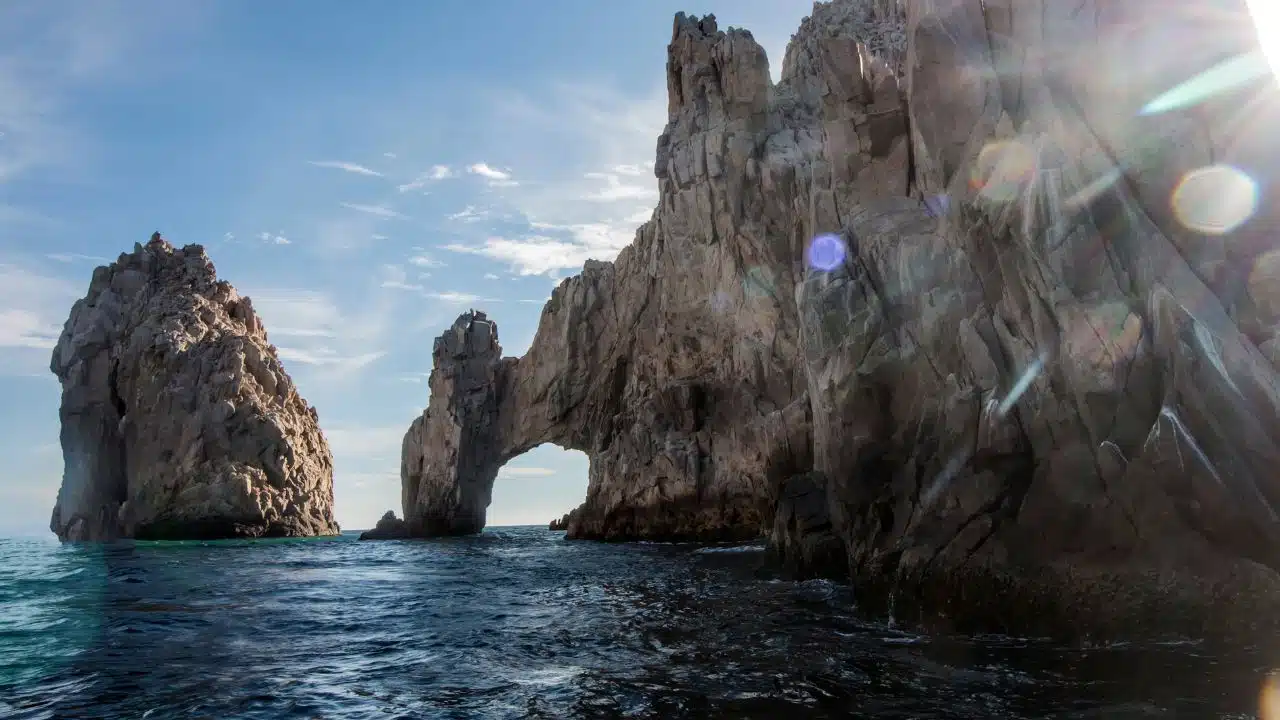Dubbed “the world’s aquarium” by marine explorer and conservationist Jacques-Yves Cousteau, the Sea of Cortez off Cabo’s coast becomes near magical during the winter. Known as one of the premier places to experience whale season, Cabo promises unforgettable shows. Experience fan-favorite whale species like the humpback and chance encounters with other whale species like the sperm whale.
If you want an unmatched trip and to take your winter escapades to new heights, forget the snow and consider a trip to the tropics. Here’s your guide to whale season in Cabo, from the best time to visit to the best tours and encounters.
Table of Contents
- What Time of Year Is Best for Whale Watching in Mexico?
- What Kinds of Whales Can You See During Whale Watching Season?
- 5 Fun Whale Watching Tours to Experience Whale Season in Cabo
- Save Big on Flights to Whale Season in Cabo with Next Vacay
What Time of Year Is Best for Whale Watching in Mexico?
The best time of year to whale watch in Mexico is from December to April. But make no mistake, escaping the cold winter air elsewhere is just a bonus. The real treat of traveling in winter is seeing these majestic kings of the ocean as you’ve never seen them before.
The Cabo San Lucas whale-watching season conveniently coincides with the winter months. Still, many visitors travel to Mexico as early as October to glimpse adult humpback whales dominating the sea.
December marks the official start of the season, but January is when the waters truly come alive. Baby whales make their stunning debut, and more diverse whale populations crowd the Sea of Cortez, from the enormous blue whales to the elusive sperm whales and the curious gray whales.
What Is the Best Month to See Whales in Cabo San Lucas?
While you can go whale watching at any time during whale season, February stands out as the prime time for Cabo whale-watching tours. During the month of February, the majority of whale species make an appearance, including blue whales, gray whales, fin whales, and humpbacks.
Thankfully, the Cabo San Lucas whale-watching season stretches from December to April. So, if you can’t swing a February trip, you can still experience a one-of-a-kind whale-watching adventure.
What Kinds of Whales Can You See During Whale Watching Season?
The arrival of winter might cause groans elsewhere in the world, but it’s an entirely different story in the warm waters of Cabo San Lucas. While whale watching in Cabo is a favored pastime for many, for others, it’s one of the sole reasons they travel to Los Cabos in the first place. Whether you’re one of the former or the latter, Cabo San Lucas promises a spectacle, from common whale sightings to rare and lucky encounters.
Humpback Whales
The iconic humpback whale is the most common whale swimming in the waters of Cabo San Lucas. In person, a humpback whale, with its distinctive hump and long pectoral fins, is a sight to behold. And thanks to their playful and showy nature, catching a glimpse of them is almost guaranteed. Whether it’s loving moms teaching baby humpback whales how to breach and tail slap or competitive males fighting for the attention of a lone female, the humpback whales of Los Cabos put on heart-warming and heart-pounding shows year after year.
Humpback Whale Season in Cabo: The Sea of Cortez is home to adult humpback whales as early as October. However, the best time to join a whale-watching tour is from February to March.
Gray Whales
A rare sight in other parts of the world, Cabo San Lucas is one of the few places on earth blessed with sightings of these inquisitive and playful creatures. Following the longest migration of any marine animal on earth, the gray whale arrives in the welcoming lagoons of Baja California Sur to raise their young. Eager and outgoing calves will often swim right up to the boat and engage in friendly splashing competitions with each other as if to see who can create the more impressive display.
Gray Whale Season in Cabo: Visit Magdalena Bay and Puerto San Carlos between January and March to have your heart captured by the playful antics of gray whales and their calves.
Blue Whales
The largest creature to ever walk the earth doesn’t walk at all; it swims. Blue whales are the largest animal on earth, growing as big as 100 feet long and weighing 330,000 pounds. To put these behemoth creatures into perspective, their heart alone is roughly the size of a dairy cow. As such, it’s no surprise their babies can measure up to 26 feet at birth, though we can’t say it won’t be a shock to see it firsthand!
Blue Whale Season in Cabo: If you’re having a hard time picturing blue whales in your head, see their stunning beauty in person between February and March in Loreto.
Bryde’s Whales
Contrary to other baleen whales, Bryde’s whales are the only ones to spend their entire lives in tropical and subtropical waters. They keep their migrations short, and some populations do away with migrating altogether, becoming “residents” of an area instead. When your home is in the tropics, who wants to migrate anyway?
Bryde’s Whale Season in Cabo: These warm-water-loving cetaceans adore the Sea of Cortez almost as much as humans do, meaning they can be found year-round in Mexico’s friendly waters.
Sperm Whales
These colossal giants are easy to pick out thanks to their uniquely shaped heads. Blue whales may be large and in charge, but even they can’t compete with the sperm whale’s big brain. Its massive head hides the largest brain in the animal kingdom!
In general, sperm whales are a bit of an anomaly. They don’t share many features with their other whale counterparts, from their small pectoral fins to their 52 conical teeth, weighing over two pounds each, and their single, angled blowhole on the left-hand side. Sperm whales are built different, which makes them a sight to behold while you’re whale watching.
Sperm Whale Season in Cabo: While sperm whale sightings are rare, your best bet for encountering these lovable oddballs is during the summer months.
Fin Whales
Second only to the blue whale in size, fin whales can reach up to 85 feet long and are found all over the world. And while their name isn’t as common as their giant cousin in most circles, the reason for its name makes it a pretty easy cetacean to spot when whale-watching. Thanks to the fin on its back near its tail, you’ll have no trouble recognizing this particular whale while on the water.
Fin Whale Season in Cabo: February to March is the best time to try spotting the fin whale’s trademark feature.
Whale Sharks
It’s a whale; it’s a shark—it’s a whale shark! Okay, but what is it really? Whale sharks are actually sharks, but if you’ve seen them in person, they have much more in common with whales than sharks, from their massive bodies to enormous mouths. Whale sharks can grow up to 40 feet long, making them the largest fish in the sea. Like whales, these marine animals are filter-feeders too. And despite their size, these giants are quite gentle, making swimming with whale sharks one of Cabo’s biggest draws.
Whale Shark Season in Cabo: Catch your best glimpse of these stunning cetaceans between January and March in La Paz.
Killer Whales
Whale or dolphin? Depending on your classification, some say both! Killer whales have always been curious creatures with the intelligence to rival humans. They’re also similar to humans in another important aspect: they inhabit every ocean in the world.
Killer Whale Season in Cabo: You can spot killer whales here year-round, though doing so might be more challenging than you think. A safe bet is to follow the food.
5 Fun Whale-Watching Tours to Experience Whale Season in Cabo
The Cabo whale watching season is the sole reason many flock to the shores of Baja California Sur. After all, breaching humpbacks and singing blue whales aren’t everyday experiences. It all comes down to timing and location. Thankfully, the whale-watching tour companies of Cabo San Lucas have had years to perfect their craft to deliver an incomparable experience.
1. Zodiac Whale Watching Adventure
Cabo Expeditions Zodiac whale-watching tours bring the action to you. With an experienced guide who knows the best locations for whale watching in Cabo and the smaller and more maneuverable zodiac boat, this whale-watching adventure gives you a front-row seat to the best spy-hopping, fin-slapping, and tail-waving action.
2. Snorkel & Whale Watching
Experience all the fun of the sea by combining a whale-watching tour with a snorkeling tour. Few things can improve upon a thrilling whale encounter. But like the cherry on top of a delicious fudge sundae, rounding out your exciting whale-watching adventures with a fun romp around one of Cabo’s premier snorkeling spots sounds like a pretty good deal.
3. Whale Watching with Breakfast
Hop aboard a two-level catamaran and get swept away on this tour that combines breakfast treats with gorgeous vistas of Cabo’s landmark scenery and majestic whales. While you drink in the views, grab a Bloody Mary from the open bar and toast “Salud” to a fun morning of whale-watching.
4. Thar She Blows! Whale Watching Pirate Cruise
How do you make whale-watching in Cabo San Lucas even more exciting? By adding a bit of pirate magic. Guests are spirited away on a pirate ship to scour the Baja California Peninsula in search of elusive whales, learning fun facts about their quarry and the pirates that used to sail the seas.
5. Whale Watching Photo Safari Tour
Everyone loves a good photo tour, and these photogenic cetaceans are the perfect subject for a photo safari. The excursion takes you on a tour of the best whale-watching spots in Cabo San Lucas to capture one-of-a-kind photos of whales as they play, leap, and splash back into the ocean.
Save Big on Flights to Whale Season in Cabo with Next Vacay
Whale-watching in Cabo San Lucas is a treat few enjoy, but one that everyone should get to experience. And with Next Vacay, you can!
Score inexpensive flights to Mexico, where you can enjoy morning cruises and pirate voyages to see whales, whale sharks, and killer whales populating the seas. Whether planning a family vacation, a honeymoon getaway, or a solo adventure, watch their playful antics from up close and create unbelievable memories. Fly for cheap and whale watch in paradise with Next Vacay.



